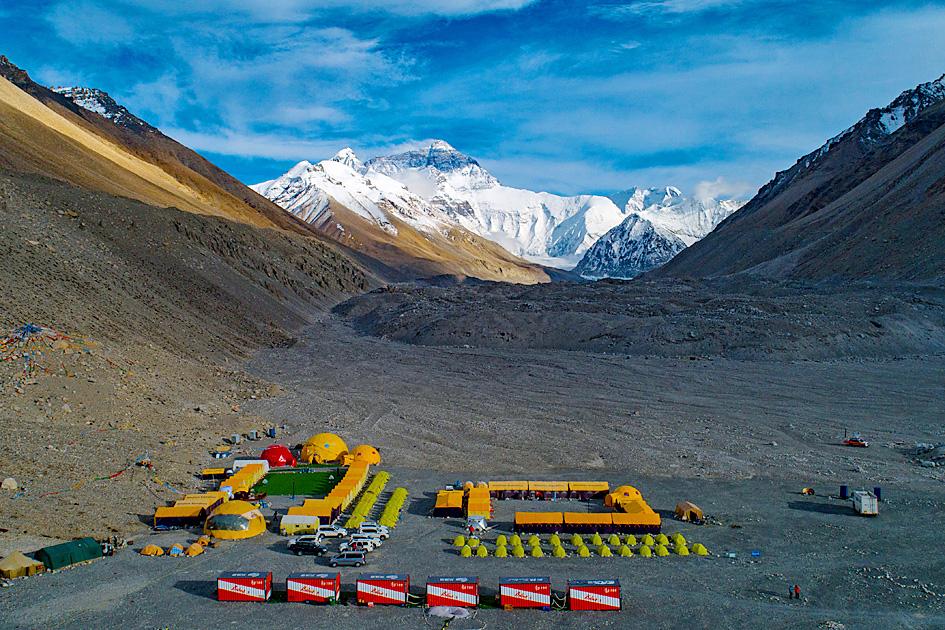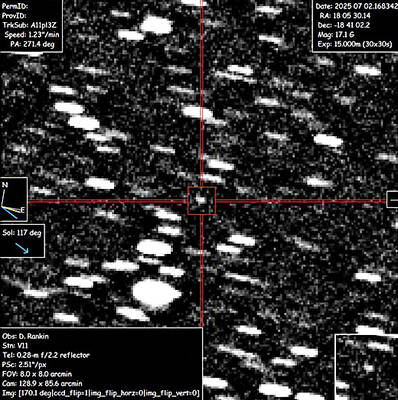China would set up a “separation line” on the peak of Mount Everest to avoid possible COVID-19 infections by climbers from virus-hit Nepal, state media reported, after dozens were taken ill from the summit’s base camp.
Although the virus first emerged in China in late 2019, it has largely been brought under control in the country through a series of strict lockdowns and border closures.
More than 30 sick climbers were evacuated from base camp on the Nepalese side of the world’s highest peak in the past few weeks as Nepal faces a deadly second wave, raising fears that the virus might ruin a bumper climbing season.

Photo: AP
Mount Everest straddles the China-Nepal border, with the north slope belonging to China. Tibetan authorities told reporters at a news conference that they would take the “most stringent epidemic prevention measures” to avoid contact between climbers on the north and south slopes or at the top, the official Xinhua news agency reported on Sunday.
Mountain guides will set up dividing lines on the summit of the mountain before allowing mountaineers to start the grueling climb up, the head of the Tibet Mountaineering Association was quoted as saying by Xinhua.
The official did not provide details on what the dividing lines would be made of.
Twenty-one Chinese climbers have been approved to climb to the summit of Everest this year after having quarantined in Tibet since early last month, the official added.
The Chinese side would also step up virus control measures at the Chinese base camp on the northern side of the mountain, with non-climber tourists in the Everest scenic area forbidden to enter.
China has banned foreign nationals from climbing Everest since last year due to the COVID-19 outbreak, but this year Nepal has issued a record number of climbing permits to try and boost visitors after its tourism industry was devastated last year from the pandemic.
An Everest permit alone from Nepal costs US$11,000 and climbers pay upward of US$40,000 for an expedition.

Two former Chilean ministers are among four candidates competing this weekend for the presidential nomination of the left ahead of November elections dominated by rising levels of violent crime. More than 15 million voters are eligible to choose today between former minister of labor Jeannette Jara, former minister of the interior Carolina Toha and two members of parliament, Gonzalo Winter and Jaime Mulet, to represent the left against a resurgent right. The primary is open to members of the parties within Chilean President Gabriel Boric’s ruling left-wing coalition and other voters who are not affiliated with specific parties. A recent poll by the

TENSIONS HIGH: For more than half a year, students have organized protests around the country, while the Serbian presaident said they are part of a foreign plot About 140,000 protesters rallied in Belgrade, the largest turnout over the past few months, as student-led demonstrations mount pressure on the populist government to call early elections. The rally was one of the largest in more than half a year student-led actions, which began in November last year after the roof of a train station collapsed in the northern city of Novi Sad, killing 16 people — a tragedy widely blamed on entrenched corruption. On Saturday, a sea of protesters filled Belgrade’s largest square and poured into several surrounding streets. The independent protest monitor Archive of Public Gatherings estimated the

Irish-language rap group Kneecap on Saturday gave an impassioned performance for tens of thousands of fans at the Glastonbury Festival despite criticism by British politicians and a terror charge for one of the trio. Liam Og O hAnnaidh, who performs under the stage name Mo Chara, has been charged under the UK’s Terrorism Act with supporting a proscribed organization for allegedly waving a Hezbollah flag at a concert in London in November last year. The rapper, who was charged under the anglicized version of his name, Liam O’Hanna, is on unconditional bail before a further court hearing in August. “Glastonbury,

FLYBY: The object, appears to be traveling more than 60 kilometers per second, meaning it is not bound by the sun’s orbit, astronomers studying 3I/Atlas said Astronomers on Wednesday confirmed the discovery of an interstellar object racing through the solar system — only the third-ever spotted, although scientists suspect many more might slip past unnoticed. The visitor from the stars, designated 3I/Atlas, is likely the largest yet detected, and has been classified as a comet, or cosmic snowball. “It looks kind of fuzzy,” said Peter Veres, an astronomer with the International Astronomical Union’s Minor Planet Center, which was responsible for the official confirmation. “It seems that there is some gas around it, and I think one or two telescopes reported a very short tail.” Originally known as A11pl3Z before